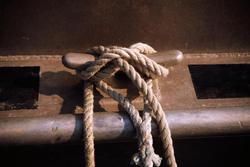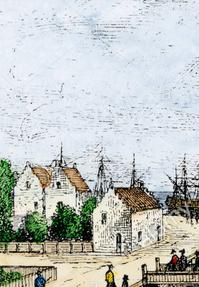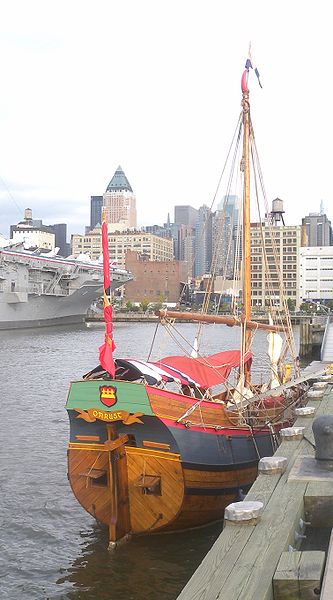The Fulkerson Family Pages
Text authored by Bob Fulkerson, from his site Fulkerson.org, with edits and added info and links in 2015.
Click here to read about the Household of Dirck Holgerson de Noorman and Christine Vigne.
Documents, such as a ship's passenger list, have not been found to give a definite date of Grandfather Dirck's arrival in New Amsterdam. Digging around in NYC historic archives to try to find this information could make a worthy project for an NY-area family member.
In 2014, to commemorate the 400 years since the founding of the original colony on Manhattan, a group of history enthusiasts undertook The Onrust Project and created a replica of Adriaen Block's ship (pictured above).
Hendrick Christiaensen was among the first to have been bitten by the Terra Nova (Earth New) trade bug. Christiaensen may have hired a ship with Adriaen Block; but Adriaen Block was likely the go-getter. Arnout Vogels, Leonart Pelgrom and Francoys Pelgrom chartered the ship 'St. Pieter' of 60 lasts (120 tons) on May 19, 1611, captained by Cornelis Rijser, Citizen of Amsterdam. The ship was manned by 13 and carried three passengers. The ship and sailed to trade at places appointed by the merchants. If trade should prove insufficient the crew was to help with fishing.
Vogels had traded in furs in Canada, with Van Tweenhuysen and Hans Hunger, the brothers Leonart and Francoys Pelgrom, they formed the first company to carry on trade in New Netherland.
Soon also, the Jonge Tobias, captained by Thijs Volckertsen Mossel, would be the first ship embarking on a trading voyage to the Native American island of Mannahatta, carrying Juan Rodriguez, the first documented non-native resident of what would eventually become New York City, predating the Dutch settlers. Born in Santo Domingo (now in the Dominican Republic) to a Portuguese sailor and an African woman, Rodriguez is also considered the first immigrant, the first person of African heritage, the first person of European heritage, the first merchant, the first Latino, and the first Dominican to settle in Manhattan.
In The Prehistory of the New Netherland Company, by Simon Hart, there is an involved discussion of the dramas going on between the earliest ship captains in the teen years of the 1600's and their crews as they began staking out trade and territory in the area. Within this account is the relation of an incident regarding Thijs Volckertsen Mossel and Adriaen Block (Tygjer a.k.a. The Tiger) . Another version of Mossel's name is oft-mentioned, and it is uncertain whether Mossel has any connection to Dirck de Noorman and Christine Vigne.
There is speculation regarding the manner (i.e. upon which ship) and timing of the arrival in the New Netherlands colony by Christine's parents, Guillame and Adrienne Vigne.
Per the 375th Anniversary of the Eendracht nd Nieuw Nederland by Harry Macy, Jr. (NYG&B Newsletter, Winter 1999) Ghislain and Adrienne (Cuvellier) Vigne and their children Marie, Christine, and Rachel were on either Niew Nederland or De Eendracht, as their son Jan would be recorded as the first male child born in the new colony.
The New Amsterdam colony spent a considerable amount of effort at record keeping, taking great care to write deeds, contracts and other agreements, as well as keeping detailed court records. New Amsterdammers were frequently found offending the law or suing one another.
Many details of Dirck's life are known to us from the legal documents of that era, where his name sometimes appears as Dirck Volckertszen of that era, translations of which appeared in the New York Historical Manuscripts (referred to as NYHM in further citations) and similar works.
More Name Complications
Dirck was identified in a 1635 document as Dirck Volgersen the Noorman.
A 1639 map listed his bouwerie (farm) as the "Bou. van Ditryck de Norman."
Several historians and three independent family records call him Volckertsen, Volkertszen, and Volkertsen. These variations all have a Dutch "-sen" or "-szen" ending.
The "ck" letter combination is also Dutch. Some legal and civil documents really throw us for a loop and called him Holgerson or Holgersen.
The records of the Dutch Reformed Church (he was a witness at several baptisms) called him Volckertszen.
Perhaps Dirck's surname actually started out as Holgerson or HOLGERSSØN, which the New Amsterdammers then transformed into the Dutch name Volckertszen? This would not have happened simply through differences in pronunciation. The Dutch had words and names that began with an "H" and which were not pronounced with a "V." (Perhaps adding insult to injury, one current genealogist insists on calling him Dirck DORKSON!) What did not help were poor spelling consistency among administrators of widely varying schooling and literacy, on top of records written in barely discernible handwriting on faded and crumbling paper documents.
Dirck seemingly settled this matter for us when he named his first son Volkert. Even that fact, however, leaves open for consideration whether Holgerson or Holgerss was an additional part of his name. The history of another immigrant illustrates this possibility, and strongly reinforces Dirck's Norwegian origin:
"Albert Andriessen, or Albert Andriessen Bradt [Bratt] was one of the earliest Norwegian settlers in New Netherland. He came from Fredrikstad, a town at the mouth of the Glommen, the largest river in Norway. In the early records he is often called Albert de Noorman (the Norwegian). After 1670 he became known as Albert Andriesz Bradt."
Source: Lorine McGinnis Schulze
http://olivetreegenealogy.com/nn/surnames/bradt.shtml
Historians have settled the matter by giving Dirck's last name as Volckertsen, or Volckertszen, except when referring to one of those documents in which his name appeared as Holgerson or Holgersen.
We will try to remain as consistent as possible to reduce confusion, so Dirck Volckertszen or Dirck De Noorman will be our name for him on this site, as often as possible.
Starring in Early American Documents--Grandfather Dirck Made a Name for Himself
Terra Nova: A Popular Voyage Destination
Continue to Fulkerson Family Holdings: Our Lost Fortune in NYC Real Estate




